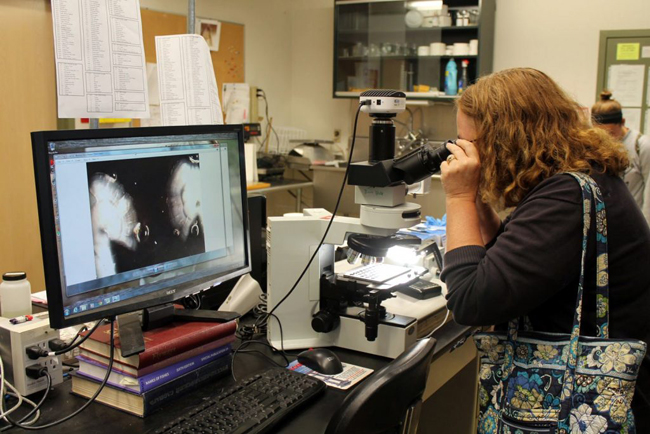
Above, an examination of fish ears, called otoliths, helps determine the age of the fish. Photo: Kara Lynn Dunn
Buffalo, NY, June 1, 2016 - Ever wondered how fish hear, what they eat, or what they might say about the conditions of a local river?
New York Sea Grant (NYSG) educators can help you find answers to these and other questions about living in the eastern end of the Great Lakes region.
K-12 educators who attend summer workshops with NYSG Coastal Education Specialist Helen Domske - the recent recipient of a Distinguished Scientist Award - may examine fish ears, called otoliths, under a microscope to determine the age of a fish, dissect fish guts to analyze its diet, or visit with weather forecasters at the National Weather Service: Buffalo.
“First-hand experience is the basis for building exciting lesson plans to engage youth in becoming environmental stewards,” Domske says.
This “teach the teacher” approach, which engages educators in experiential learning with classroom-tested curriculum, was developed by NYSG and the National Oceanic and Atmospheric Administration (NOAA). Workshop participants infuse Great Lakes information on topics from algal blooms to zooplankton into their classrooms to prompt student interest in the environment. Student-led projects created as a result have included beach and stream cleanups, building and installing wood duck nest boxes, and local invasive species mapping.
Domske also periodically leads workshops that take place aboard US research vessels monitoring the Great Lakes, offering teachers the opportunity to directly interact with scientists working on Lake Erie and Lake Ontario. In 2014 and 2015, Domske worked with nearly 250 teachers who impacted the lives of nearly 25,000 students.
After a workshop along the Buffalo River, Amanda Jasper of the Global Concepts Charter School in Lackawanna, New York, concentrated instruction in her Advanced Placement Biology curriculum on the history and environmental concerns of the river. Her students created a public service announcement video to raise awareness of local issues.
Williamsville High School students took a “LEAP” forward with teacher Kim Preshoff, starting a Leaders for Environmental Awareness and Protection (LEAP) Club. They established a plastic water bottle recycling program to reduce the waste stream, and encouraged use of refillable bottles.
In addition to NOAA, partners in this educational outreach have included the U.S. Environmental Protection Agency, the Center for Great Lakes Literacy, the New York State Department of Environmental Conservation, universities and colleges, and local organizations and site managers.
—Kara Lynn Dunn, Great Lakes Publicist, New York Sea Grant
More Info: New York Sea Grant
New York Sea Grant (NYSG), a cooperative program of Cornell University
and the State University of New York, is one of 33 university-based
programs under the National Sea Grant College Program (NSGCP) of the
National Oceanic and Atmospheric Administration (NOAA). The NSGCP
engages this network of the nation’s top universities in conducting
scientific research, education, training and extension projects designed
to foster science-based decisions about the use and conservation of our
aquatic resources. Through its statewide network of integrated
services, NYSG has been promoting coastal vitality, environmental
sustainability, and citizen awareness about the State’s marine and Great
Lakes resources since 1971.
New York Sea Grant maintains Great Lakes offices at SUNY Buffalo, the
Wayne County Cooperative Extension office in Newark and at SUNY Oswego.
In the State's marine waters, NYSG has offices at Stony Brook University
and Stony Brook Manhattan, in the Hudson Valley through Cooperative
Extension in Kingston and at Brooklyn College.
For updates on Sea Grant activities: www.nyseagrant.org has RSS, Facebook, Twitter, and YouTube links. NYSG also offers a free e-list sign up via www.nyseagrant.org/coastlines for its flagship publication, NY Coastlines/Currents, which is published several times a year.